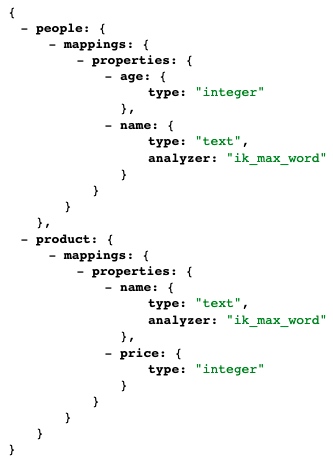原文链接 https://lanffy.github.io/2019/07/10/Elasticsearch-Common-Usage-Manual
注:以下为加速网络访问所做的原文缓存,经过重新格式化,可能存在格式方面的问题,或偶有遗漏信息,请以原文为准。
前面几篇文章介绍了搜索引擎ElasticSearch的内部原理,这篇文章总结了在ElasticSearch使用过程中常见的用法。
1、查看集群信息
ElasticSearch 查看集群健康信息,常用命令如下:
1.1、查看集群状态
ElasticSearch查看集群状态命令:
curl 'localhost:9200/_cat/health?v'

其中,status为绿色表示一切正常, 黄色表示所有的数据可用但是部分副本还没有分配,红色表示部分数据因为某些原因不可用.
1.2、查看索引分片情况
ElasticSearch查看索引分片情况命令:
curl 'localhost:9200/_cat/shards?v'

可以看到例子中有两个索引分别是:people和product,他们各有一个主分片和一个尚未分配的副分片。
1.3、查看节点信息
ElasticSearch查看节点信息命令:
- 主节点:
curl 'localhost:9200/_cat/master?v' - 所有节点:
curl 'localhost:9200/_cat/nodes?v'
2、索引相关命令
2.1、创建索引
ElasticSearch创建索引命令。
7.0版本去掉了type的概念。
2.1.1、7.0之前版本创建索引
curl -X PUT 'localhost:9200/product' -H 'Content-Type: application/json' -d '
{
"mappings": {
"type_name": {
"properties": {
"price": {
"type": "integer"
},
"name": {
"type": "text"
}
}
}
}
}'
2.1.2、7.0及其之后的版本创建索引
curl -X PUT 'localhost:9200/product' -H 'Content-Type: application/json' -d '
{
"mappings": {
"properties": {
"price": {
"type": "integer"
},
"name": {
"type": "text"
}
}
}
}'
2.2、查询索引
ElasticSearch查询所有的索引命令。
curl 'localhost:9200/_cat/indices?v'

可以看到上面的例子中,集群中有两个索引。他们的名字分别为:people、product。且分别有一个主分片和副分片。
2.3、查询索引结构
2.3.1、查看所有的索引mapping数据结构
ElasticSearch查询索引mapping结构命令:
curl 'localhost:9200/_mapping?pretty'

上面的例子查询了索引people和product的mapping数据结构。
2.3.2、查看指定的索引mapping数据结构
2.3.2.1、7.0之前版本
查看索引名为indexName且type名为typeName的索引mapping数据结构:
curl -XGET "127.0.0.1:9200/indexName/typeName/_mapping?pretty"
2.3.2.2、7.0及其之后版本
查看索引名为indexName的索引mapping数据结构:
curl -XGET "127.0.0.1:9200/indexName/_mapping?pretty"
2.4、给索引添加字段
ElasticSearch在索引中添加字段命令
2.4.1、7.0之前版本
curl -XPOST "127.0.0.1:9200/indexName/typeName/_mapping?pretty" -H 'Content-Type: application/json' -d '{
"typeName": {
"properties": {
"tags":{
"type":"text"
}
}
}
}'
上面的例子,表示给索引名为indexName且type名为typeName的mapping数据结构添加tags字段
2.4.2、7.0及其之后版本
curl -XPOST "127.0.0.1:9200/product/_mapping?pretty" -H 'Content-Type: application/json' -d '{
"properties": {
"tags":{
"type":"text"
}
}
}'
上面的例子,表示给索引名为product的mapping数据结构添加tags字段
2.5、索引中删除字段
ElasticSearch现在不支持
2.6、删除索引
ElasticSearch 删除某个索引命令。
curl -X DELETE 'localhost:9200/product'
上面的例子表示删除名为product的索引。
3、数据文档搜索查询相关命令
下面提到的数据即索引中的文档。
Tips:如果安装ES的时候设置了用户名和密码,在查询的时候通过下面的方式带上用户名和密码:
curl -X GET --user username:password '127.0.0.1:9200/index/_search?ignore_unavailable=true&pretty' -H 'Content-Type: application/json' -d '{}
- ignore_unavailable=true : 忽略索引不存在的报错
3.1、写入数据命令
ElasticSearch写入数据命令.
7.0版本去掉了type的概念。
3.1.1、7.0之前版本写入数据
curl -X PUT 'localhost:9200/product/type_name/1' -H 'Content-Type: application/json' -d '
{
"price":1,
"name":"富士山苹果"
}'
3.1.2、7.0及其之后的版本写入数据
curl -X PUT 'localhost:9200/product/_doc/1' -H 'Content-Type: application/json' -d '
{
"price":1,
"name":"富士山苹果"
}'
3.2、搜索查询数据命令
ElasticSearch搜索数据命令
3.2.1、7.0之前版本搜索数据
3.2.1.1、主键搜索
curl -X GET 'localhost:9200/product/type_name/1?pretty'
3.2.1.2、关键字搜索
curl -X GET 'localhost:9200/product/_search?pretty' -H 'Content-Type: application/json' -d '
{
"query": {
"match": {
"name": "苹果"
}
},
"from":0,
"size":1
}'
3.2.2、7.0及其之后的版本搜索数据
3.2.2.1、主键搜索
curl -X GET 'localhost:9200/product/_doc/1?pretty'
3.2.2.2、关键字搜索
curl -X GET 'localhost:9200/product/_search?pretty' -H 'Content-Type: application/json' -d '
{
"query": {
"match": {
"name": "苹果"
}
},
"from":0,
"size":1
}'
3.2.3、对多值的字段搜索
查询name包含“苹果”且tags有“苹果”或者“富士山”的文档数据:
curl -X GET 'localhost:9200/product/_search?pretty' -H 'Content-Type: application/json' -d '{
"query":{
"bool":{
"must":[
{
"bool":{
"should":[
{"match":{"name":"苹果"}},
{"terms": {"tags": ["苹果","富士山"]}}
]
}
}
]
}
},
"sort":{
"_score":{"order":"desc"}
},
"from":0,
"size":10
}'
3.2.4、多字段联合查询
查询name包含“苹果”且price为1的文档数据:
curl -X GET 'localhost:9200/product/_search?pretty' -H 'Content-Type: application/json' -d '{
"query":{
"bool":{
"must":[
{
"bool":{
"should":[
{"match":{"name":"苹果"}},
{"match":{"price":1}}
]
}
}
]
}
},
"sort":{
"_score":{"order":"desc"}
},
"from":0,
"size":10
}'
3.2.5、查询有安全认证的ES
当ES设置了用户名和密码时,通过命令行查询需要带上用户名和密码,命令如下:
curl --user elastic:123456 -X GET http://localhost:9200/product/_doc/1?pretty
{
"_index" : "noah",
"_type" : "_doc",
"_id" : "1",
"_version" : 1,
"_seq_no" : 1,
"_primary_term" : 1,
"found" : true,
"_source" : {
"name" : "王义凯",
"age" : 28,
"email" : "wangyikai@csdn.com",
"company" : "CSDN"
}
其中,--user传的时用户名(elastic)和密码(123456)
3.3、更新数据命令
ElasticSearch中更新数据命令:
curl -X PUT 'localhost:9200/product/_doc/1' -H 'Content-Type: application/json' -d '
{
"price":1,
"name":"富士山苹果",
"tags":["富士山","名牌","苹果"]
}'
3.4、删除数据
ElasticSearch中删除文档数据命令:
3.4.1、7.0之前版本
删除一个文档
curl -XDELETE 'http://localhost:9200/indexName/typeName/1'
上面的例子表示删除索引名为indexName且type名为typeName的索引中文档ID为1的文档。
3.4.2、7.0及其之后的版本
curl -XDELETE 'http://localhost:9200/indexName/_doc/1'
3.5、聚合查询、聚合搜索
按照host聚合
curl -X GET '127.0.0.1:9200/index/_search?ignore_unavailable=true&pretty' -H 'Content-Type: application/json' -d '{
"query": {
"match": {
"field": "test"
}
},
"size":0,
"aggs": {
"Hosts": {
"terms": {
"field": "host",
"size":10000
}
}
}
}'
在指定的时间段内统计聚合,下面的查询,统计指定时间段内,每3600秒按照host字段聚合
curl -X GET '127.0.0.1:9200/index/_search?ignore_unavailable=true&pretty' -H 'Content-Type: application/json' -d '{
"query": {
"match": {
"field": "test"
}
},
"size":0,
"aggs": {
"Monitor": {
"date_histogram": {
"field": "requestTime",
"interval": "3600s",
"format": "yyyy-MM-dd HH:mm:ss",
"min_doc_count": 0,
"extended_bounds" : {
"min" : "2020-11-04 00:00:00",
"max" : "2020-11-05 00:00:00"
}
},
"aggs":{
"host": {
"terms": {
"field": "host",
"size":10000
}
}
}
}
}
}'
聚合后去重,下面的查询,每3600秒按照host聚合统计pv,然后在结果里面按照username去重,统计uv
curl -X GET '127.0.0.1:9200/index/_search?ignore_unavailable=true&pretty' -H 'Content-Type: application/json' -d '{
"query": {
"match": {
"field": "test"
}
},
"size":0,
"aggs": {
"Monitor": {
"date_histogram": {
"field": "requestTime",
"interval": "3600s",
"format": "yyyy-MM-dd HH:mm:ss",
"min_doc_count": 0,
"extended_bounds" : {
"min" : "2020-11-04 00:00:00",
"max" : "2020-11-05 00:00:00"
}
},
"aggs":{
"host": {
"terms": {
"field": "host",
"size":10000
},
"aggs":{"uv": {
"cardinality": {
"field": "username"
}
}}
}
}
}
}
}'
4、ElasticSearch中分词器分析器在命令行中的用法
ElasticSearch支持不同的分词插件,在下面的例子中我们使用了analysis-ik分词插件。
通过ElasticSearch的API接口,可以分析不同分词器的分词结果1。具体的步骤如下:
4.1、添加两个字符类型的字段,并指定不同的分词器:
curl -XPOST "127.0.0.1:9200/product/_mapping?pretty" -H 'Content-Type: application/json' -d '{
"properties": {
"pNameIkMaxWord":{
"type":"text",
"analyzer":"ik_max_word"
},
"pNameIkSmart":{
"type":"text",
"analyzer":"ik_smart"
}
}
}'
4.2、使用ik_max_word分词分析
curl -XPOST 'http://localhost:9200/product/_analyze?pretty' -H 'Content-Type: application/json' -d '
{
"field": "pNameIkMaxWord",
"text": "中华人民共和国国歌"
}'
分词结果如下:
{
"tokens" : [
{
"token" : "中华人民共和国",
"start_offset" : 0,
"end_offset" : 7,
"type" : "CN_WORD",
"position" : 0
},
{
"token" : "中华人民",
"start_offset" : 0,
"end_offset" : 4,
"type" : "CN_WORD",
"position" : 1
},
{
"token" : "中华",
"start_offset" : 0,
"end_offset" : 2,
"type" : "CN_WORD",
"position" : 2
},
{
"token" : "华人",
"start_offset" : 1,
"end_offset" : 3,
"type" : "CN_WORD",
"position" : 3
},
{
"token" : "人民共和国",
"start_offset" : 2,
"end_offset" : 7,
"type" : "CN_WORD",
"position" : 4
},
{
"token" : "人民",
"start_offset" : 2,
"end_offset" : 4,
"type" : "CN_WORD",
"position" : 5
},
{
"token" : "共和国",
"start_offset" : 4,
"end_offset" : 7,
"type" : "CN_WORD",
"position" : 6
},
{
"token" : "共和",
"start_offset" : 4,
"end_offset" : 6,
"type" : "CN_WORD",
"position" : 7
},
{
"token" : "国",
"start_offset" : 6,
"end_offset" : 7,
"type" : "CN_CHAR",
"position" : 8
},
{
"token" : "国歌",
"start_offset" : 7,
"end_offset" : 9,
"type" : "CN_WORD",
"position" : 9
}
]
}
4.3、使用ik_smart分词分析
curl -XPOST 'http://localhost:9200/product/_analyze?pretty' -H 'Content-Type: application/json' -d '
{
"field": "pNameIkSmart",
"text": "中华人民共和国国歌"
}'
分词结果如下:
{
"tokens" : [
{
"token" : "中华人民共和国",
"start_offset" : 0,
"end_offset" : 7,
"type" : "CN_WORD",
"position" : 0
},
{
"token" : "国歌",
"start_offset" : 7,
"end_offset" : 9,
"type" : "CN_WORD",
"position" : 1
}
]
}
系列文章
- ElasticSearch源码解读一:源码编译和Debug环境搭建
- ElasticSearch源码解读二:启动过程详解
- Elasticsearch源码解读三:创建索引过程详解
- Elasticsearch源码解读四:搜索过程详解
- Elasticsearch源码解读五:搜索相关性排序算法详解
- Elasticsearch源码解读六:ES中的倒排索引
- Elasticsearch源码解读七:常见用法手册
-
https://elasticsearch.cn/article/771 ↩